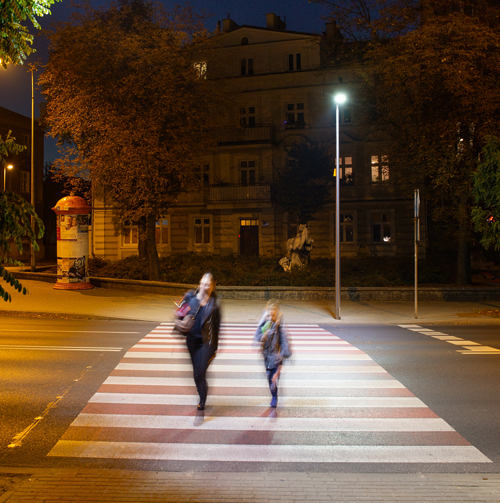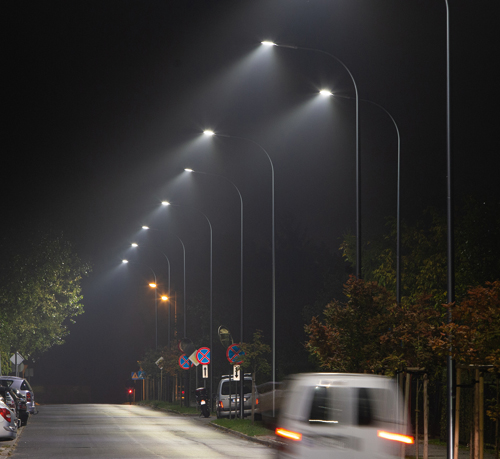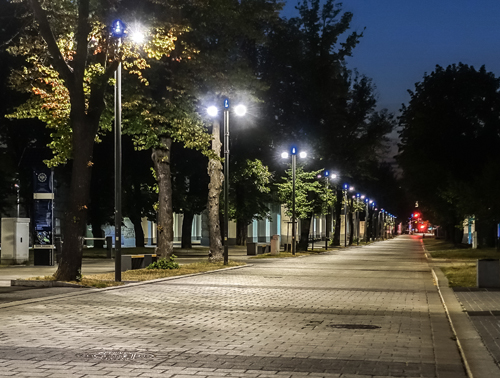Lighting the way to tomorrow
Feature
The world’s largest Internet of Things project for street lighting so far can be found in San Diego. By the end of last autumn, 3,200 sensors in the city’s street lights (which have been replaced with energy-efficient models) had been connected to the LTE network. Improvements can thus be made to the city’s traffic and parking management, while the roads and streets have thus been made safer and the air quality monitored at the same time. The sensors, which transmit data in real time, can also be used to alert drivers to free parking spaces and to assist the emergency services. The costs for the project come to almost USD 30 mln, but the city authorities are not ruling out expanding it by installing another 3,000 sensors.
Kalisz is one of the Polish cities that has decided to upgrade its lighting system
Several benefits at once
Cities in Poland are also increasingly opting to replace traditional street lighting with energy-efficient alternatives. The energy savings that can be made by installing LED lights together with an advanced control system are estimated at up to 60 pct. Smart lighting also fits in perfectly with the smart city concept, which many Polish cities are planning to embrace in the near future. Such changes are also being driven not just by the low efficiency of traditional light sources but by the fact that electricity prices continue to rise. As a result, many cities and municipalities are having to reorganise their budgets to find funds for investment in energy-efficient lighting. Although the purchase of new light fittings costs money, it is possible for such schemes to pay for themselves in a few years as the savings are substantial.
Kalisz and Ostrów Wielkopolski are among the towns that have chosen to go down the road of such investment and around 2,000 LED lights have been installed as a result. The new fittings have been integrated into the Interact City lighting infrastructure management system through which each element can be remotely monitored and controlled using a mobile device. In deciding to modernise the system, both towns had similar goals: to increase the comfort of residents and to invest in systems that reduce energy consumption and are also environmentally friendly. Lighting specialists Ouid supervised the execution of the project. “We were convinced mainly by the savings and greater control you get with LED lighting and Interact City. We wanted to reduce energy consumption and be able to adjust the light intensity to our needs,” explains Grzegorz Sapiński, the mayor of Kalisz. “Most of the areas covered by the project in Ostrów Wielkopolski are residential estates with single-family housing, in specific places where the residents want to feel safe. That’s why we decided to invest in modern lighting,” adds Beata Klimek, the mayor of Ostrów Wielkopolski.
“Local authorities are opting to modernise existing light installations, increasingly guided by concern for the environment as well as the safety of residents and road users,” says Rafał Gawrylak, the CEO of ES-System
It’s brighter in Bytom
A lighting modernisation project is also underway in Bytom. Almost 2,230 street lights will be replaced with new LED lighting under the project. It should be brighter and safer in the town’s parks, on the streets and on the squares. The town also hopes that bills will fall and electricity consumption will be halved. The modernisation work, which began in July, is being carried out by FBSerwis. It will involve the assembly of new LED fittings with a power reduction system as well as the dismantling and utilisation of old fittings. The costs of the project come to around PLN 3.4 mln. Electricity costs are expected to decrease from PLN 535,000 to PLN 289,000 per year. This will result not only from the use of modern lighting fittings but also from the reduction of power at night when the car and pedestrian traffic is negligible. “According to our calculations, the cost of electricity will be reduced by app. PLN 250,000 per year. Road lighting maintenance costs will also decrease. There are also the environmental aspects: energy efficiency, the durability of the system and the reduction of carbon dioxide emissions. Furthermore, the new lighting will illuminate the town without dazzling anyone,” promises Mariusz Wołosz, the mayor of Bytom. The modernisation will also reduce the phenomenon of light pollution. Modern fittings direct the light better, making it less intrusive. Funds of PLN 508,000 have already been allocated for the project from the town budget. Bytom is also applying for PLN 2.882 mln in funding from the Regional Operational Programme of the Silesian Province for 2014–2020 (under the European Regional Development Fund).
Comprehensively and stunningly
Warsaw is also planning a comprehensive overhaul of the public lighting in the capital. “We want to modernise the lighting on thirteen streets over the next two years. The changes are expected to generate savings of more than PLN 335,000 per year in electricity consumption,” reveals Karolina Gałecka, spokesperson for the Warsaw Municipal Road Authority [ZDM]. Cables, power cabinets, posts and almost 1,000 light fittings are to be replaced. The budget for the entire project amounts to PLN 12.5 mln, most of which (PLN 10.8 mln) will be covered by a long-term loan from the National Fund for Environmental Protection and Water Management, which the Warsaw city council has agreed to. This is to be paid out in two tranches in 2020 and 2021, and should be repaid over 2021–2026. Four companies have entered the tender to carry out the work. The bids, which are currently being scrutinised, range from PLN 306,000 to PLN 879,000. “If the tender is successfully completed, the contractor will have time to draw up detailed plans for the projects by mid-December. After the completion of this stage, we will be able to launch the project, carrying out work on thirteen Warsaw streets,” adds Karolina Gałecka. In her opinion, introducing LED lighting will generate average electricity savings of almost 60 pct – more than PLN 335,000 per year. Moreover, the repair and maintenance costs of modern fittings will be much lower, which means that the investment should pay for itself within a few years. The city also wants to improve visibility at pedestrian crossings. “We have just announced a tender for additional lighting in 117 such places. Meanwhile, a contractor is currently being selected for illuminating another 188 crossings. We want to improve visibility at almost 400 pedestrian crossings in 2019. The tender involves the replacement of old, worn out lamp-posts and fittings in fourteen districts of Warsaw. The new posts will be equipped with LED lighting, which is much brighter than older types and uses less electricity. This will improve safety and save money on electricity,” claims Karolina Gałecka of ZDM.
Traditional lighting is also being replaced with energy-saving equivalents in Kraków. A total of 16,700 LED street lights out of more than 72,000 across the city have already been installed. “The replacement of sodium lamps with LED lights is being gradually carried out throughout the city, as financial resources are obtained. Furthermore, the remote management and control system for the street lighting is continuing to be rolled out,” the Kraków Road Authority [ZDMK] has told us. Boulevards in the city, including Czerwieński and Kurlandzki, have recently been given intelligent lighting, which adjust to the light intensity of the particular season and time of day. And stylish lamp-posts have been added for this purpose. The installation of a monitoring system and a Wi-Fi network is also a feature of the project.
Some of the new street lighting in Ostrów Wielkopolski. Intelligent lighting is now regarded as one of the essential components of a smart city
Remote control
More and more cities are deciding to replace their public lighting, encouraged to some degree by the state-run ‘Sowa – LED in External Lighting’ funding scheme for this purpose. Szczecin, one of the cities taking advantage of the scheme, has not only used the funds to buy several thousand energy-efficient fittings but also to introduce an intelligent system for managing the city’s public lighting. Szczecin council hopes that the project will accelerate the city’s development into a smart city, through the integration of the city lighting system with other intelligent platforms and the Internet of Things. The city estimates that the new light fittings will generate savings of 70 pct. The lights do not work at full power when nobody is around and each of the fittings can also be controlled remotely. The system also receives data on the technical condition of the infrastructure, so any faults are detected almost instantaneously. Due to this, the lighting can be managed more effectively. Decisions are not made on the basis of estimates, but on specific data. So it is clear where the lighting should be more intense and where its intensity can be reduced. “A lot can be done with lighting systems these days: lighting control, adjustment to the traffic intensity and the weather, the optimisation of maintenance services, quicker response times, urban property management, and the collection and analysis of data from connected sensors,” explains Tomasz Makarski, the marketing director of Lug Light Factory. In his opinion, the city is taking full control over its infrastructure thanks to the new lighting system.
Modern systems can now be used to create extraordinary lighting and illumination effects in cities. Examples of this can be found in the revitalisation of Szczecin’s boulevards and the modernisation of the lighting in Zielona Góra, which were carried out by Lug Light Factory. “We were able to achieve unusual lighting effects that not only complement the local architecture but also fits in with its spirit,” claims Tomasz Makarski.
Inspiration for the authorities
One model of the lighting of the future has been installed at the Nowe Żerniki residential estate in Wrocław. The estate has been designed according to the latest urban trends as an open space with no fences, barriers or gates. Lighting in a variety of colours has been used to set clear boundaries between the residential and functional zones of the estate. Philips Lighting Luma fittings have been installed at two heights, of five and eight metres, together with special lens caps and backlighting limiters, which means that the light only goes where it is needed. Meanwhile, the Lumimotion system has been employed to detect or stop movement by adjusting the light intensity accordingly. In pedestrian areas the lamps emit warm light, and white light where there is vehicular traffic. The system also regularly generates reports on the need for maintenance or the replacement of damaged parts, which reduces the cost of maintaining the entire lighting infrastructure. “We wanted to demonstrate to residents how LED lighting promotes increases safety. During the day we navigate spatially but at night we are led by artificial public lighting instead of by the sunlight,” explains Piotr Fokczyński, the director of the department of architecture and construction, the city architect and the coordinator of the Nowe Żerniki project.
“Intelligent lighting is one of the components of the smart city concept, which on the macro-scale covers the entire urban conurbation and on the micro scale is specific to residential estates, the best example of which is Nowe Żerniki. The innovativeness of this project is reflected not only in the number of technological systems used but above all by their quality and focus on achieving specific goals. This project provides an inspiration for local authorities and urban architects in terms of how to use modern and proven systems, both today and in the future,” believes Bogdan Rogala, the general manager of Signify Eastern Europe (formerly Philips Lighting Poland)
Soul of architecture
“Local authorities are opting to modernise existing light installations, increasingly guided by concern for the environment as well as the safety of residents and road users. By adopting an appropriate design, lighting modernisation brings energy savings and increases the quality and functionality of lighting systems, which is particularly important in the context of rising energy costs. Outdoor LED lighting installations equipped with intelligent control systems are able to reduce energy consumption significantly compared to existing, unmonitored systems,” points out Rafał Gawrylak, the CEO of ES-System. One of the latest projects by the company in the field of intelligent urban lighting was the modernisation of street lighting in the Raciechowice administrative district 30 km south-east of Kraków. The project involved replacing 403 street lamps. The company has also recently replaced the lighting in the Angel City apartment complex in Kraków and on ul. Bagienna in Katowice, as well as for national road S5 and the pier in Kołobrzeg.
Street lighting is an essential element of urban space. Adequately positioned street lamps improve safety and reduce the risk of road accidents, theft and acts of violence. They also generate budgetary savings. Modern urban lighting systems adjust the light intensity to the weather conditions and traffic. Electricity consumption is also reduced – but these are not their only advantages. Street lights can also be equipped with traffic management modules and Wi-Fi. Modernising outdated infrastructure and replacing lighting with LEDs is also an ideal opportunity to connect it to the Internet of Things. You can also highlight the most attractive parts of the city. So the only thing to do for us all is to invest in it.






















































